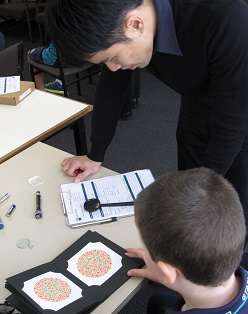Classroom study measures vision and NAPLAN achievement

QUT researchers have investigated how vision can affect a child's ongoing learning, with results showing 30 per cent of Year 3 students tested had uncorrected eye problems that could affect their NAPLAN performances.
Importantly, the children referred for further optometric examination had significantly lower NAPLAN scores in Reading, Spelling, Grammar and Punctuation, and Numeracy subtests.
The study has been published in the International Journal of Education Research.
Dr Sonia White, Senior Research Fellow from QUT's Faculty of Education said 109 Year 3 students were involved in the multidisciplinary study that combined optometry and education research, and was funded by the Ian Potter Foundation.
"Children's eyes need to be tested early in primary school and throughout schooling to ensure they can fully engage with the visual aspects of classroom learning," Dr White said.
Joined by Professor Joanne Wood, Dr Alexander Black and Dr Shelley Hopkins from QUT's School of Optometry and Vision Science, Institute of Health and Biomedical Innovation (IHBI), Dr White said the ongoing research has involved six schools across South-east Queensland.
"In our current follow-up project, funded by the Lord Mayor's Charitable Foundation (Eldon & Anne Foote Trust Donor Advised Program 2015), we are investigating whether vision intervention one year earlier, in Year 2, can ameliorate the differences in achievement we saw in the Year 3 children," Professor Wood said.
"We hypothesise that early vision interventions could support children's development of literacy and numeracy and subsequent classroom learning and achievement."
Dr White said vision screening and assessment was not currently mandated prior to children commencing school, which may mean that some of the children will have vision and visual processing difficulties that remain undetected by parents and teachers.
Dr White said schools that were involved in the study had anecdotally reported big improvements, with some children showing a marked increase in their reading level and greater classroom participation.
As well as vision assessment, children completed a range of near vision learning tasks, such as reading and mathematics, while eye tracking was used to examine specific visual processing behaviours underlying these activities.
"The aim is to level the playing field in terms of vision and provide every opportunity for learning and academic achievement for children in school and later life," Professor Wood said.
More information: Sonia L.J. White et al. Vision screening outcomes of Grade 3 children in Australia: Differences in academic achievement, International Journal of Educational Research (2017). DOI: 10.1016/j.ijer.2017.03.004
Provided by Queensland University of Technology


















